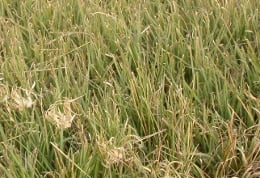An Introduction to Buffalograss
If you’re intending to plant a lawn, you’ll know that there are only a handful of suitable grass species to choose from. You also may be hesitating because of the costs associated with maintaining a lawn. Supplemental watering, expensive fertilizer treatments, herbicides, pesticides, fungicides, and you-name-it-cides—is it really worth it?
The good news is that a low-maintenance lawn is possible. Meet the species commonly known as buffalograss (Buchloe dactyloides). What makes this species so special? It is the only lawn species that is native to North America. This characteristic has some impressive advantages over other grass species. First, it needs very little supplemental watering. It can tolerate and survive severe droughts, while other grass species, such as the overly thirsty Kentucky bluegrass, cannot. It also has very low fertilizer requirements. At the most, it needs 1 to 2 lbs. of pure nitrogen per 1,000 sq. ft. of lawn, per year. Some grass species need 2 to 3 times that much! It also grows fairly slowly, so you don’t have to mow it as frequently. Not fond of mowing at all? You could even leave your buffalo grass lawn unmowed if you don’t mind a more natural look.
Buffalograss is the perfect lawn for lawn owners who don’t want to spend their weekends completing a checklist of tasks in their yard. But having such a low-maintenance lawn does come with a few drawbacks that are important to be aware of.
First of all, buffalograss doesn’t require much energy to grow in terms of water or fertilizer, but it does require full sunlight. Any shade, even partial shade, will kill it. If you’re set upon having this type of lawn, you will have to remove any trees or shrubs that shade the yard. Otherwise, you will have to plant a blend of grass seed that includes more shade-tolerant species.
Also, the lawn is best left alone - period. It doesn’t respond well to intense maintenance, but it also doesn’t respond well to routine foot traffic. If you have kids or pets that need a yard to run around and play in, then this species is not the lawn for you. Bottom line, it is better for visual rather than recreational enjoyment.
 As a warm-season grass, it thrives in warmer temperatures, and will grow most actively during the heat of summer, a direct contrast to cool-season lawns like Kentucky bluegrass and perennial ryegrass, which are struggling to remain green during that season. However, it has very little tolerance for cool temperatures. It tends to go dormant by turning brown whenever temperatures drop below 55ºF. The further south you live, the less important this is. But if you live in the transitional zone, you may have a brown lawn for six months out of the year. Some lawn owners compensate for this problem by overseeding their lawns in the fall with perennial ryegrass seed, which keeps the lawn green until the spring.
As a warm-season grass, it thrives in warmer temperatures, and will grow most actively during the heat of summer, a direct contrast to cool-season lawns like Kentucky bluegrass and perennial ryegrass, which are struggling to remain green during that season. However, it has very little tolerance for cool temperatures. It tends to go dormant by turning brown whenever temperatures drop below 55ºF. The further south you live, the less important this is. But if you live in the transitional zone, you may have a brown lawn for six months out of the year. Some lawn owners compensate for this problem by overseeding their lawns in the fall with perennial ryegrass seed, which keeps the lawn green until the spring.
Buffalograss is certainly not the right lawn choice for everyone. But if you are interested in native plants, want a no-fuss lawn, and prefer your lawn’s aesthetic over its recreational potential, then you should take a look at the buffalo grass seed products available.


